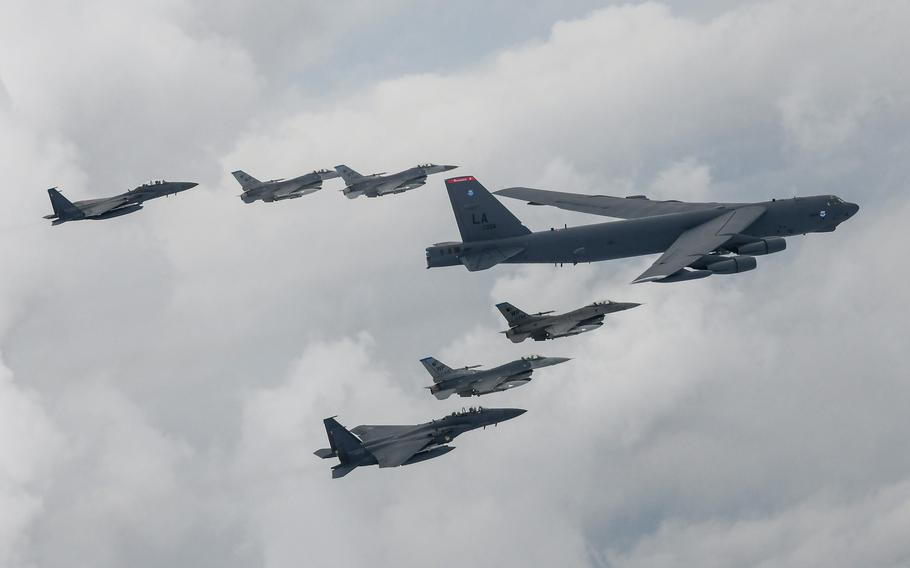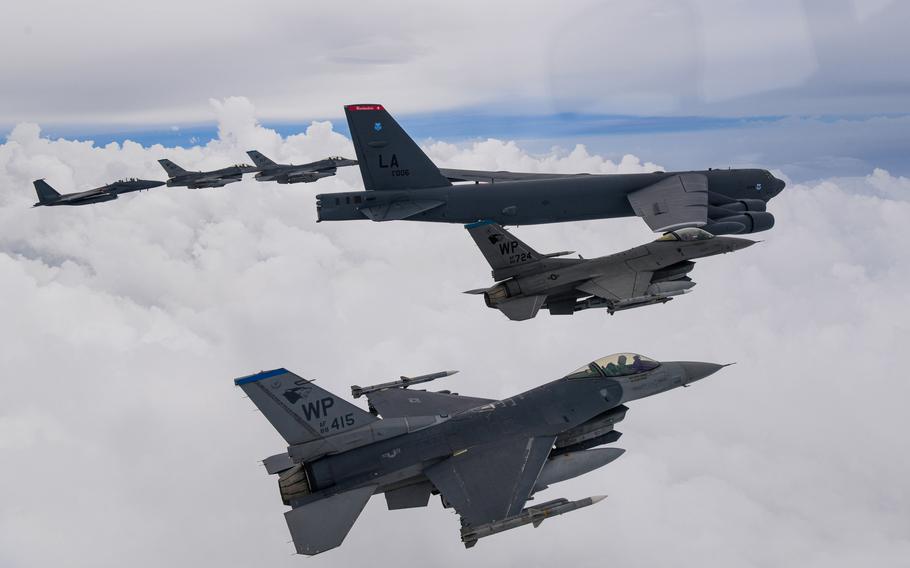
U.S. F-16 Fighting Falcons and South Korean F-15K Slam Eagles escort a B-52H Stratofortress bomber over the Korean Peninsula, Thursday, July 13, 2023. (South Korean Ministry of National Defense)
CAMP HUMPHREYS, South Korea — The U.S. and South Korean air forces conducted a bomber escort drill a day after North Korea fired an intercontinental ballistic missile that achieved a new flight record.
Three South Korean F-15K Slam Eagles flew alongside U.S. F-16 Fighting Falcons and a B-52H Stratofortress bomber over the Korean Peninsula, according to a news release late Thursday from the South’s Ministry of National Defense.
Four U.S. F-16s accompanied the B-52H during the drill, 7th Air Force spokeswoman Maj. Rachel Buitrago said in an email Friday.
Aircraft tail markings from photos released by the ministry showed the F-16s were assigned to the 8th Fighter Wing at Kunsan Air Base and the B-52H was assigned to Barksdale Air Force Base, La.
B-52s from Barksdale arrived at Andersen Air Force Base, Guam, on July 5 as part of a bomber task force mission, one of an ongoing series intended to project U.S. airpower in the region, Pacific Air Forces said in a news release Tuesday.

U.S. F-16 Fighting Falcons and South Korean F-15K Slam Eagles escort a B-52H Stratofortress bomber over the Korean Peninsula, Thursday, July 13, 2023. (South Korean Ministry of National Defense)
The joint air drill over South Korea was conducted “in a timely manner” and showcased the allies’ military capabilities and commitment to defend South Korea, according to the ministry’s release.
The demonstration came a day after North Korea fired its second, solid-fueled Hwasong-18 ICBM, which flew 74 minutes, a record for the regime’s missile program. It was fired around 10 a.m. Wednesday from the Pyongyang area and splashed into the East Sea, or Sea of Japan, 155 miles west of Okushiri Island, outside of Japan’s exclusive economic zone.
The test “fully demonstrated the might” of the North’s missile program, the state-run Korean Central News Agency reported Thursday.
North Korea last fired the Hwasong-18 on April 13, prompting the Japanese government to warn people in Hokkaido to seek shelter.
The ICBM launch was condemned Wednesday at the NATO summit in Lithuania by South Korean President Yoon Suk Yeol, Japanese Prime Minister Fumio Kishida, Australian Prime Minister Anthony Albanese and New Zealand Prime Minister Chris Hipkins.
“Even if North Korea continues to develop its nuclear and missile programs and threaten the use of nuclear weapons, it will only bolster the international community’s resolve to achieve [the] complete denuclearization of North Korea,” said a joint statement from the four leaders.
The North fired the ICBM two days after accusing the U.S. and South Korea of violating its airspace on multiple occasions this month. North Korea’s Defense Ministry in a statement published by KCNA on Monday alleged U.S. surveillance aircraft had flown into the country’s airspace; Washington and Seoul denied the claim.